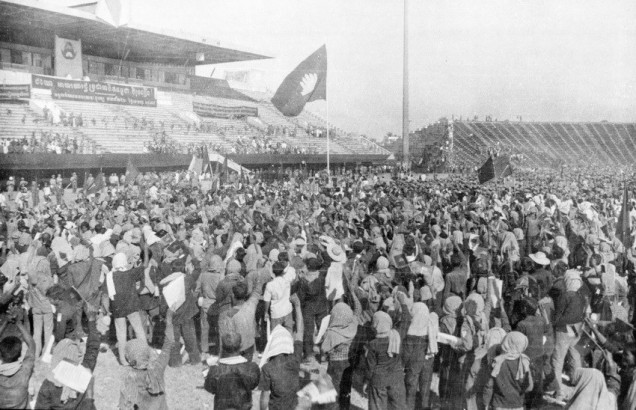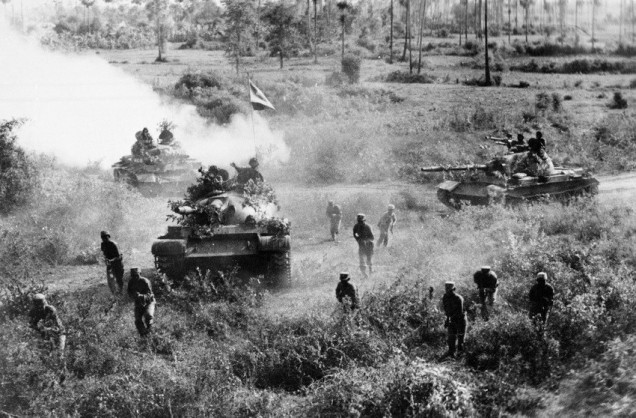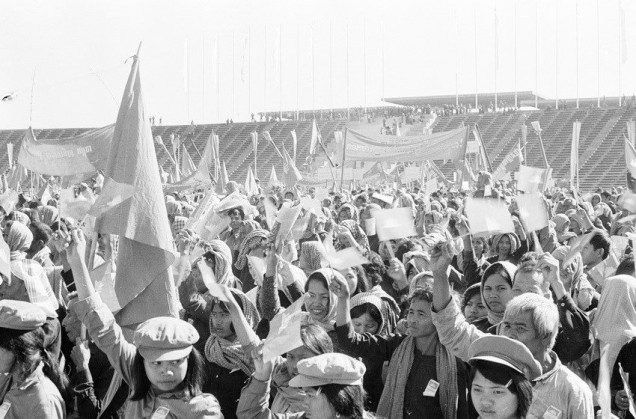![Beer1]()
It is an indisputable fact that Cambodians love their beer. Whether it’s a simple get-together between friends or a lavish wedding ceremony, it seems that there is always an occasion to crack a can, pour into an ice filled glass and ch’oul moy with fellow drinkers.
For a relatively small country, Cambodia has more than its fair share of home brewed beverages, from recognised international brands, such as Tiger and Heineken, regional tipples like ABC and Anchor, to the local favourite tipples of Angkor, Cambodia and Black Panther.
Whilst the current trend turns to man-bun sporting, bearded millennials sipping craft ale in ironic drinking horns, formulated using micro-brewing techniques, the staple part of the vast majority of locals (and foreigners) drinking is from the cheap and readily available cans, bottles and kegs of commercial grade ‘swill’. Who doesn’t enjoy formaldehyde after a hard day in Cambodia?
Cambodian Breweries
As the standard of living improves across the region, luxury goods, such as relatively expensive imported beers have become widespread, but there are four major breweries knocking out in Cambodia.
The largest and oldest is the Angkor Brewery facility, in Sihanoukville. Designed by the late legendary Khmer architect Vann Molyvann, and officially opened in 1965 by the then Prince Sihanouk, the plant was closed in 1975 due to the on-going civil war. Taken over by the Malaysian company Cambrew Ltd in 1991, the refurbished factory was once again pumping out beer the following year. Danish brewing giant Carlsberg now controls a 50% stake in the firm.
Another major European company, Heineken, also control a 50% stake in the country’s second biggest beer supplier- Cambodia Brewery Ltd (CBL), based in Phnom Penh.
Across town is the only Cambodian owned brewery and relative new kid on the beer block, with production beginning in 2011, The Khmer Brewery, from Khmer Beverages Ltd.
The most recent addition is the German branded Ganzberg, which, thanks to heavy promotion is also a common sight in every province.
These four suppliers produce the most recognised and heavily imbibed amber nectar in the kingdom, so which are from where?
Beers- the 5%ers
![BeerAngkor]()
The most successful brand produced by Cambrew is their signature Angkor beer. Slightly darker than the pilsner style of its rivals, Angkor is the most ubiquitous ’50 cent Happy Hour’ draught on offer in bars. Although the famous ‘My Country, My Beer’ slogan has been slightly altered, Angkor still claims to be Cambodia’s best selling beer, mainly due to the volume it seems to give away along the riverside in Phnom Penh and the ‘Happy All Day Hour- 50 cent Draft’- which have been causing singlet wearing sexpats and TEFLers alike to forget to extend their visas since shortly after UNTAC rolled out the country.
Taste- **
Quaffability- **
Value- ****
Hangover- *****
Comments: Cheap piss water with a full bodied flavour. Has traditionally had the distinction of giving drinkers a hangover before finishing the glass, although improvements can be noted since Carlsberg has been invovled.
![BeerAnchor]()
The biggest competitor to Angkor is Anchor Smooth (pronounced An-choor), from CBL. Whilst some would complain it lacks flavour, it is probably the most favoured brew of choice for foreigners, largely due to its ease of drinking uncountable numbers of cold cans on a typically hot day. For the hangover alone, it’s worth the extra 25-50c in a bar. This is also the brew of choice for the Hash House Harriers drinking group.
Taste- ****
Quaffability- ****
Value- ***
Hangover- **
Comments: Light, easy to consume pilsner, lacking in taste other than aluminium.
![BeerCambodia]()
The third mainstay of the main beers is Cambodia, another pale pilsner, but with a little more flavour than Anchor. Ring pull promotions- from free cans (around 1 in 5 is another can) to motorcycles make Cambodia beer a big seller, in both cities and provinces. Many a session has been extended as another half box is collected from the ‘gift’ pulls, and enough 500r have been collected for the ‘free’ cans.
Taste- ***
Quaffability- ****
Value- *****
Hangover- ***
Comments: Similar enough to Anchor, with a soupçon more metallic bite. Worth it for the winners. It will be interesting to see how long the pull tabs will stay in existence, as many Western countries have already banned them, and it’s increasingly difficult to find production of them.
![BeerGanzberg]()
Coming in at fourth amongst the 5% crowd is German recipe pilsner, Ganzberg, which although seen everywhere and with heavy, and often stupid marketing, still isn’t as popular as the big 3, despite the prizes on offer (free cans around 1 in 6). Most expats seem to reject it outright, but plenty of people must be drinking it, somewhere out there. Having been stuck with a few cases, we can confirm that after about the 5th or 6th ice cold can, the negative Gnaztyburg vibes slip away into a woozy feeling of elation and increased self-esteem on a karaoke microphone. The hangovers are bad.
Taste- **
Quaffability- **
Value- ****
Hangover- *****
Comments: Mix the worst parts of Angkor, Anchor and Cambodia together, let it mellow and remove the good parts. Best served ice cold.
The Budgeteers
![BeerCrown]()
Another CBL beer is Crown, which at 4.5% packs less of a punch than Anchor, but is a few dollars cheaper on a case of 24, so popular amongst rural Khmer drinkers. The trouble is that it’s watery, and made even more so when consumed on ice, as is the habit out in the Boondocks. Crown also seems to lose is fizz quite quickly, and watery, flat beer makes me vomit; not from the alcohol, but watery and flat beer upsets my delicate gag reflex (the same happens when somebody else starts puking or when a shitty nappy is anywhere close by) – I’d be terrible at gay porn scenes. On the plus side, whenever any Cambodian labourers are doing work on your property, it is customary etiquette to fork out for a box of beer at the end of the week/job. Crown is perfect as it is cheap and there is less worry about them getting home safely that evening on a moto with no headlights.
Taste- **
Quaffability- **
Value- *****
Hangover- ****
Comments: Weaker and and more watery than Sam Rainsy’s resolve. A driving beer.
![BeerKlang]()
The king of provincial beers must be the notorious Klang. Better known as domrei, or elephant, the 6% brew not only packs a punch, but is also considerably cheaper than most other offerings in the countryside. Whilst the slightly chemical taste might put of the connoisseur, after a few cans it goes down quicker than your mum on a first date. After flying high like superman on a mix of ethanol, hops and methamphetamine precursors, the elephant comes crashing in the next day, often with sick on the floor, turds like treacle and a mighty klangover.
Taste- **
Quaffability- ***
Value- *****
Hangover- *****
Comments: Without a doubt wears the crown of the khets. Your brain, sphincter and liver will hate you, but who cares when, for a few sweet hours, you are the lizard king?
The Stouts
Whilst lager-type beers are undoubtedly refreshing, the market for strong, black and malty stouts is huge in Cambodia.
![BeerABC]()
The go-to for middle-class locals is ABC stout. An 8% black beer, brewed by CBL, and at around 3x the price of a regular beer, is as much a status symbol as a drink. Often seen being drunk by uniformed police officers at 7am, it is the breakfast, lunch and dinner of champions, despite it being relatively expensive and not actually that nice. Whilst difficult to knock back quickly, ABC does pack a punch when compared with the girly lagers.
Taste- ***
Quaffability- *
Value- **
Hangover- ****
Comments: Fool your boss/father in law/local authorities into thinking you are richer, more suave and sophisticated than you really are by arriving at any social occasion with a box of ABC. They’ll all be too busy getting rat arsed on the freebies that they wouldn’t even notice that you have the alcohol tolerance of a teenage Mormon.
![BeerAnchorStout]()
Cambrew have two brands of stout out. The 8% Angkor Extra Stout is only available in 330ml and 640ml bottles, and can occasionally be found on tap. Although not too bad, it will always be the poorer cousin of ABC.
Taste- ***
Quaffability- *
Value- ***
Hangover- ****
Comments: It’s a strong beer, but won’t cut no respect in the hood. Plus nobody takes the empties away.
![BeerBlackPanther]()
If Angkor Extra Stout is the poorer cousin of ABC, then Cambrew’s second bier noire is unashamedly the trailer trash dwelling, oxycontin smokin’crack whore of the family. Black Panther gets you more fucked up than a blue eyed 10 year old at a priest convention. It lacks any style and finesse and tastes like a failed homebrew experiment mixed with paint thinners, but at 50 cents a tin, offers a respite from reality for the poor, wretched, downtrodden and overstayed huddled masses. It’s also a good cooking ingredient for beef, or so I tell the wife when pouring half a can into a wok with frying onions, then shotting the rest back in one, warm.
Taste- **
Quaffability- **
Value- ****
Hangover- *****
Comments: Not for pregnant women, children, those suffering from heart problems, lightweights or poofs.
![BeerCrwonStour]()
The budget stout from CBL’s parent company, Asia-Pacific Breweries is a slightly weaker 6.5% Crown Stout- which is essentially the same as Crown, only blacker and stronger. If you’re going to ruin you renal functions and puke blood, with cheap Cambodian stouts, you might as well do it properly with an 8% beverage, rather than pussyfoot around with this one. Crown Stout tastes a bit like burnt rice was used in the brewing process.
Taste- *
Quaffability- *
Value- ****
Hangover- ****
Comments: Why bother summoning Mammon when you can get the direct line to Beelzebub?
![BeerBarrley]()
Not to be outdone, Khmer Beverages (Cambodia) have begun to produce a dark brew, Barrley Black. It has some adverts making it look all upmarket, but to be honest, I haven’t actually tried any.
International
With further international investment and production capacity growing, international brands, such as Tiger and Heineken are now being produced in Cambodia for local consumption, as well as export. With other smaller breweries, such as Kingdom and Phnom Penh Brewery competing for a pint-sized place in the market, it is easy to see why Cambodians are the region’s heaviest beer swillers and life expectancy for locals and expats alike is pretty low.
























































